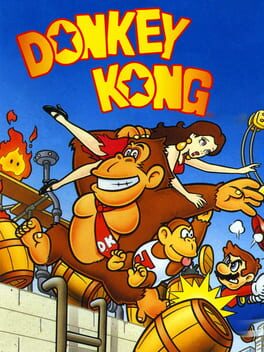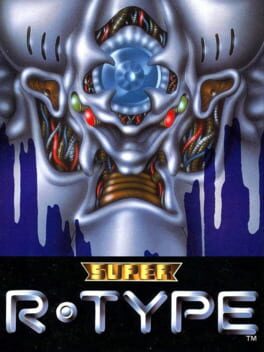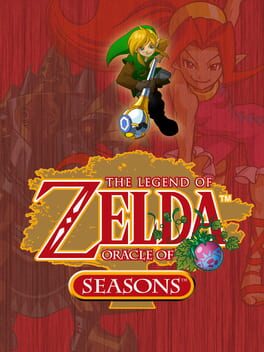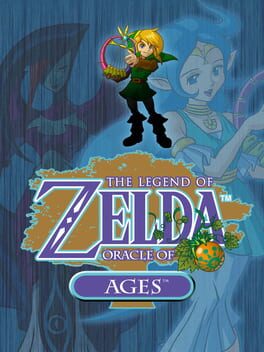Jteich2
Bio
Nothing here!
Badges

Organized
Created a list folder with 5+ lists

Noticed
Gained 3+ followers

Well Written
Gained 10+ likes on a single review

Gone Gold
Received 5+ likes on a review while featured on the front page

Liked
Gained 10+ total review likes

Gamer
Played 250+ games

GOTY '22
Participated in the 2022 Game of the Year Event

3 Years of Service
Being part of the Backloggd community for 3 years

N00b
Played 100+ games
Favorite Games
375
Total Games Played
009
Played in 2024
116
Games Backloggd
Recently Played See More
Recently Reviewed See More
Note: This playthrough of Oracle of Seasons was played as the sequel to Oracle of Ages via the Linked Game feature
What strikes me most about Oracle of Seasons is how different the overall experience feels from Oracle of Ages. While both games in the duology were released on the same day in 2001 and look similar at a glance, Zelda fans of the era were treated to two unique adventures. A common refrain for these games is that Ages focuses on puzzles while Seasons focuses on combat. I personally find this view is a bit simplistic as dungeons in both games contain elements of puzzles and action. Rather, each of these games channel different modes of exploration that the Zelda series tends to draw from. And these modes of exploration can clearly be seen through the design of each game's overworld.
Oracle of Ages is a puzzle-led exploratory action game. The world of Labrynna is, as its name suggests, a labyrinth. It is confusing to navigate around and requires using your items to puzzle out the path to the next dungeon via the present and past timeline maps. There are specific routes and combinations of items that need to be used to navigate its world.
Oracle of Seasons is a discovery-led exploratory action game. While the overworld still gates specific areas until you get a specific item, you can explore much more of the overworld in a freeform manner. The map doesn't feel nearly as constrained in how you can navigate it. The featured item of the game, the Rod of Seasons, can manipulate how you traverse the overworld by changing the season while standing on a tree stump. This enables the discovery-led exploration. The flow of the game is such that you find a new area with a stump, manipulate the seasons, and explore the surrounding area to discover new changes in the overworld that will allow you to traverse forward. You are also encouraged to keep an eye out during exploration since secret caves, staircases, and portals can become available to you as the seasons change.
With an emphasis on discovery via exploration, Seasons specifically feels like a spiritual successor to the original Legend of Zelda on NES. Having just played the original Zelda, it was fun to spot all of the connections! The manner in which you navigate to Dungeon 1 and its appearance on the outside directly resembles Dungeon 1 in the original Zelda. Seasons also has a mechanic where you can burn bushes, bomb caves, and find other mysterious entrances to reveal old men that do a variety of things. Like in Zelda 1, these characters can steal your money, give you money, or other provide other fun secrets. Even some of the Zelda 1 dungeon bosses make a return!
The other notable feature of the Oracle games is the ability to link the games to each other to create a seamless story. After finishing Oracle of Ages, you are given a password that can be entered into Oracle of Seasons to continue the story. After doing this, Seasons will contain new plot events, a new endgame, and the ability to upgrade items by passing passwords you discover in Seasons back into Ages (and vice versa). Even after finishing Ages, I was constantly dipping back into it during my playthrough of Seasons to get secret items I could transfer back to Seasons. It sounds a bit confusing to type out but works well in practice. It's a cool system that makes these Zelda adventures feel like more than the sum of their parts.
Overall, I enjoyed the flow of Oracle of Ages slightly better than Seasons as my personal preferences for 2D Zelda slide towards puzzle-led exploration. I also connected more with Ages' world since it was a difficult experience to puzzle my way across it. But Oracle of Seasons is an excellent game in its own right and when linked with Ages, these two games provide an epic, handheld Zelda experience. The dungeons are excellent, the overworld exploration is satisfying, and the scenarios you come across are funny and memorable.
Favorite Music: I love the music in Oracle of Seasons so much more than Oracle of Ages. Playing Seasons puts into contrast what exactly I thought was missing in Ages. The town themes and dungeon themes are memorable and atmospheric. The songs below are all unique to Oracle of Seasons while my favorite songs in Oracle of Ages are shared between both games. That fact alone puts my feelings on both soundtracks into clearer focus.
Horon Village: https://www.youtube.com/watch?v=MP5BC6rgFas&list=PLD7475F03564D42CA&index=9
Dancing with Din: https://www.youtube.com/watch?v=VR8TCFjlfxM&list=PLD7475F03564D42CA&index=7
Dancing Dragon Dungeon (Level 4): https://www.youtube.com/watch?v=xhGS79bPPCI&list=PLD7475F03564D42CA&index=21
Tarm Ruins: https://www.youtube.com/watch?v=S0EumkAeEAo&list=PLD7475F03564D42CA&index=4
What strikes me most about Oracle of Seasons is how different the overall experience feels from Oracle of Ages. While both games in the duology were released on the same day in 2001 and look similar at a glance, Zelda fans of the era were treated to two unique adventures. A common refrain for these games is that Ages focuses on puzzles while Seasons focuses on combat. I personally find this view is a bit simplistic as dungeons in both games contain elements of puzzles and action. Rather, each of these games channel different modes of exploration that the Zelda series tends to draw from. And these modes of exploration can clearly be seen through the design of each game's overworld.
Oracle of Ages is a puzzle-led exploratory action game. The world of Labrynna is, as its name suggests, a labyrinth. It is confusing to navigate around and requires using your items to puzzle out the path to the next dungeon via the present and past timeline maps. There are specific routes and combinations of items that need to be used to navigate its world.
Oracle of Seasons is a discovery-led exploratory action game. While the overworld still gates specific areas until you get a specific item, you can explore much more of the overworld in a freeform manner. The map doesn't feel nearly as constrained in how you can navigate it. The featured item of the game, the Rod of Seasons, can manipulate how you traverse the overworld by changing the season while standing on a tree stump. This enables the discovery-led exploration. The flow of the game is such that you find a new area with a stump, manipulate the seasons, and explore the surrounding area to discover new changes in the overworld that will allow you to traverse forward. You are also encouraged to keep an eye out during exploration since secret caves, staircases, and portals can become available to you as the seasons change.
With an emphasis on discovery via exploration, Seasons specifically feels like a spiritual successor to the original Legend of Zelda on NES. Having just played the original Zelda, it was fun to spot all of the connections! The manner in which you navigate to Dungeon 1 and its appearance on the outside directly resembles Dungeon 1 in the original Zelda. Seasons also has a mechanic where you can burn bushes, bomb caves, and find other mysterious entrances to reveal old men that do a variety of things. Like in Zelda 1, these characters can steal your money, give you money, or other provide other fun secrets. Even some of the Zelda 1 dungeon bosses make a return!
The other notable feature of the Oracle games is the ability to link the games to each other to create a seamless story. After finishing Oracle of Ages, you are given a password that can be entered into Oracle of Seasons to continue the story. After doing this, Seasons will contain new plot events, a new endgame, and the ability to upgrade items by passing passwords you discover in Seasons back into Ages (and vice versa). Even after finishing Ages, I was constantly dipping back into it during my playthrough of Seasons to get secret items I could transfer back to Seasons. It sounds a bit confusing to type out but works well in practice. It's a cool system that makes these Zelda adventures feel like more than the sum of their parts.
Overall, I enjoyed the flow of Oracle of Ages slightly better than Seasons as my personal preferences for 2D Zelda slide towards puzzle-led exploration. I also connected more with Ages' world since it was a difficult experience to puzzle my way across it. But Oracle of Seasons is an excellent game in its own right and when linked with Ages, these two games provide an epic, handheld Zelda experience. The dungeons are excellent, the overworld exploration is satisfying, and the scenarios you come across are funny and memorable.
Favorite Music: I love the music in Oracle of Seasons so much more than Oracle of Ages. Playing Seasons puts into contrast what exactly I thought was missing in Ages. The town themes and dungeon themes are memorable and atmospheric. The songs below are all unique to Oracle of Seasons while my favorite songs in Oracle of Ages are shared between both games. That fact alone puts my feelings on both soundtracks into clearer focus.
Horon Village: https://www.youtube.com/watch?v=MP5BC6rgFas&list=PLD7475F03564D42CA&index=9
Dancing with Din: https://www.youtube.com/watch?v=VR8TCFjlfxM&list=PLD7475F03564D42CA&index=7
Dancing Dragon Dungeon (Level 4): https://www.youtube.com/watch?v=xhGS79bPPCI&list=PLD7475F03564D42CA&index=21
Tarm Ruins: https://www.youtube.com/watch?v=S0EumkAeEAo&list=PLD7475F03564D42CA&index=4
The Legend of Zelda is one of my favorite video game series and I've been interested in going back to the first entry several times over the years. I've played through parts of the first Zelda many times and beat it once during the Wii Virtual Console era. After recently playing through Oracle of Ages, which was my first time playing a 2D Zelda in a few years, I did get interested in going back to the original Legend of Zelda again. What piqued my interest this time is that while I did finish Zelda 1 many years ago, I never actually engaged with the game's Second Quest; an additional journey through Hyrule that becomes available after the credits roll. As a bit of a Zelda "completionist", I wanted to make it to the Second Quest and give it a fair shake!
From what I remember of when I played the game during the Wii era, I remember Zelda being enjoyable enough, but an experience that had aged. To give Zelda 1 a fairer shake this time around, I first decided to engage with it in the way that players in 1987 would. Back in those days, reading the manual was critical for learning the ropes of a new game! And sure enough, while the Legend of Zelda drops you into its world with no direction upon booting it up, the manual provides a ton of useful information to help get your bearings. There are descriptions of the game's key items, enemies, an unfinished map of the overworld, and hints nudging you towards the game secrets.
With this information in hand, I began another playthrough of the First Quest and I loved my time with it. One of the defining features of the Zelda series going forward would be its exploration and puzzle-solving. What's unique about this first entry is that the puzzle-solving is based on navigation. In the overworld, this takes the form of seeking out the different dungeon entrances, item shops, and secret caves. While there are many criticisms to be found of Zelda being too obtuse due to needing to "burn every bush on a screen" or "bomb every wall", I found this to not be the case. Besides one heart container, most of the caves beyond a bush or wall don't hide anything critical to the quest. The two dungeons that are hidden behind a wall or bush are pretty well telegraphed in my opinion. As long as you pay attention to the world map and retain a sense of curiosity about the world, the overworld exploration is very rewarding.
The second aspect of Zelda's game design is its dungeons; my favorite spaces in the game. In each dungeon, the puzzle of navigating a space is made more direct as you fight through gauntlets of enemies and puzzle out how to find a dungeon's special item and proceed to the boss. What made this playthrough of Zelda more special is that by the fourth dungeon of the game, I took the manual's advice and began to draw my maps for each space. The feeling of mapping out a dungeon and using it as a reference for finding secret bombable walls was a very memorable experience.
Once I was able to work my way to the credits, it was then time to begin the Second Quest. The Second Quest may seem similar to the First Quest when you start, but it is quite different. Every dungeon entrance except the first is shuffled to a new location, each dungeon has an entirely new layout, and there are new modes of traversal introduced in the dungeons. Shops and caves are also shuffled around to different locations. The Second Quest is harder, but was incredibly satisfying to puzzle out as it plays off your knowledge of the first quest. While you may not find what you expect, notable locations from the First Quest will usually hide something useful in the second quest. Mapping out each dungeon also proved to be just as critical in this second run of the game.
All in all, revisiting Zelda 1 was more rewarding than I expected after engaging with it on its terms. It's safe to say that it's now become one of my favorite games. The nature of the game design makes it easy to pick up and play, and the loop of overworld exploration feeding into dungeon exploration is incredibly satisfying. It's incredible how much of the format of future Zelda games was nailed here before being further refined in A Link to the Past!
Funnily enough, I think I also had a better experience this time around since I was using a better controller. When you want to play a game from 1987 that utilized a D-pad, it turns out that you want to use a modern controller with a good D-pad! The Switch Pro controller D-pad and Joycon D-pad options for this are...not great. I ended up using the 8BitDo Pro 2 controller which has an excellent D-pad. The game felt more responsive and I imagine is closer to the experience players had in 1987 with the NES controller.
Favorite Tracks:
Normally, I'd take the opportunity at the end of a post to highlight some of my favorite music in the game. Zelda is a funny case in that the entire soundtrack is less than 10 minutes. What is there is excellent, but there just isn't much of it! The overworld theme is iconic and has been re-interpreted many times over the years. And the Labyrinth theme is one of my favorite tracks in the series and one I wish was re-interpreted more often in future games!
Instead of picking and choosing tracks, I thought it would be fun to highlight that the soundtrack has a slightly different sound depending on whether you play the NES version or the Famicom Disk System (FDS) version of the game! The FDS has six sound channels compared to the NES' five. This sixth channel made more sounds available to composers for their music. You can see this change when comparing the title theme of the two versions. The FDS version has a fuller sound with some additional "instruments"!
NES Title Theme: https://www.youtube.com/watch?v=uyMKWJ5e1kg
FDS Title Theme: https://www.youtube.com/watch?v=W0wMU2c1MvY
Not in the game, but this symphony arrangement of the dungeon theme is one of my favorite arrangements ever: https://www.youtube.com/watch?v=5WrgY2O6xHE
From what I remember of when I played the game during the Wii era, I remember Zelda being enjoyable enough, but an experience that had aged. To give Zelda 1 a fairer shake this time around, I first decided to engage with it in the way that players in 1987 would. Back in those days, reading the manual was critical for learning the ropes of a new game! And sure enough, while the Legend of Zelda drops you into its world with no direction upon booting it up, the manual provides a ton of useful information to help get your bearings. There are descriptions of the game's key items, enemies, an unfinished map of the overworld, and hints nudging you towards the game secrets.
With this information in hand, I began another playthrough of the First Quest and I loved my time with it. One of the defining features of the Zelda series going forward would be its exploration and puzzle-solving. What's unique about this first entry is that the puzzle-solving is based on navigation. In the overworld, this takes the form of seeking out the different dungeon entrances, item shops, and secret caves. While there are many criticisms to be found of Zelda being too obtuse due to needing to "burn every bush on a screen" or "bomb every wall", I found this to not be the case. Besides one heart container, most of the caves beyond a bush or wall don't hide anything critical to the quest. The two dungeons that are hidden behind a wall or bush are pretty well telegraphed in my opinion. As long as you pay attention to the world map and retain a sense of curiosity about the world, the overworld exploration is very rewarding.
The second aspect of Zelda's game design is its dungeons; my favorite spaces in the game. In each dungeon, the puzzle of navigating a space is made more direct as you fight through gauntlets of enemies and puzzle out how to find a dungeon's special item and proceed to the boss. What made this playthrough of Zelda more special is that by the fourth dungeon of the game, I took the manual's advice and began to draw my maps for each space. The feeling of mapping out a dungeon and using it as a reference for finding secret bombable walls was a very memorable experience.
Once I was able to work my way to the credits, it was then time to begin the Second Quest. The Second Quest may seem similar to the First Quest when you start, but it is quite different. Every dungeon entrance except the first is shuffled to a new location, each dungeon has an entirely new layout, and there are new modes of traversal introduced in the dungeons. Shops and caves are also shuffled around to different locations. The Second Quest is harder, but was incredibly satisfying to puzzle out as it plays off your knowledge of the first quest. While you may not find what you expect, notable locations from the First Quest will usually hide something useful in the second quest. Mapping out each dungeon also proved to be just as critical in this second run of the game.
All in all, revisiting Zelda 1 was more rewarding than I expected after engaging with it on its terms. It's safe to say that it's now become one of my favorite games. The nature of the game design makes it easy to pick up and play, and the loop of overworld exploration feeding into dungeon exploration is incredibly satisfying. It's incredible how much of the format of future Zelda games was nailed here before being further refined in A Link to the Past!
Funnily enough, I think I also had a better experience this time around since I was using a better controller. When you want to play a game from 1987 that utilized a D-pad, it turns out that you want to use a modern controller with a good D-pad! The Switch Pro controller D-pad and Joycon D-pad options for this are...not great. I ended up using the 8BitDo Pro 2 controller which has an excellent D-pad. The game felt more responsive and I imagine is closer to the experience players had in 1987 with the NES controller.
Favorite Tracks:
Normally, I'd take the opportunity at the end of a post to highlight some of my favorite music in the game. Zelda is a funny case in that the entire soundtrack is less than 10 minutes. What is there is excellent, but there just isn't much of it! The overworld theme is iconic and has been re-interpreted many times over the years. And the Labyrinth theme is one of my favorite tracks in the series and one I wish was re-interpreted more often in future games!
Instead of picking and choosing tracks, I thought it would be fun to highlight that the soundtrack has a slightly different sound depending on whether you play the NES version or the Famicom Disk System (FDS) version of the game! The FDS has six sound channels compared to the NES' five. This sixth channel made more sounds available to composers for their music. You can see this change when comparing the title theme of the two versions. The FDS version has a fuller sound with some additional "instruments"!
NES Title Theme: https://www.youtube.com/watch?v=uyMKWJ5e1kg
FDS Title Theme: https://www.youtube.com/watch?v=W0wMU2c1MvY
Not in the game, but this symphony arrangement of the dungeon theme is one of my favorite arrangements ever: https://www.youtube.com/watch?v=5WrgY2O6xHE
The Oracle dualogy has always been a blind spot for me when it comes to the Zelda series. I was so glad to find upon diving in that not only does Oracle of Ages live up to the high bar the Zelda series has set for itself, but it also executes certain ideas better than other games in the series!
The story is fairly standard for a Zelda game. In Oracle of Ages, Link finds himself in the world of Labrynna needing to rescue the Oracle of Ages herself, Nayru from the clutches of evil. And lo and behold, you do this by spelunking through many dungeons, gaining new items, and helping the townsfolk of the world in typical Zelda fashion. The main gimmick of this game is the Harp of Ages, an item that allows you to teleport between two separate maps of Labrynna, the past timeline, and the present timeline.
Traversing through the world to locate your next objective presents itself as a puzzle box. With only the vaguest sense of direction as to where your next objective lies, you need to poke and prod at the limits of the map to chart your course. The act of getting from point A to point B can be challenging, requiring clever use of the items in your arsenal as well as spatial thinking of how the past and present world maps fit together. While the path you take through Oracle of Ages is strictly linear, I found that exploring the world still felt open-ended and rewarded my curiosity. Two aspects of the game's design are key to my feeling this way.
1. The game does not care if you get lost and do not know where to go next.
2. Your traversal of the world unfolds entirely on a continuous map.
I got lost many times throughout the adventure! However, I found that getting lost only increased the satisfaction I felt when determining the correct path forward. Since the world map you traverse is relatively small in the grand scheme of things, there are only so many places to check when figuring out where to go next. The game design allows you to get lost in the world of Labrynna but be rewarded for your exploration efforts before too long. Having your exploration take place across one continuous map also helps to instill this feeling. It feels as if you are exploring a living space rather than discrete zones.
I was surprised to find myself constantly comparing the world design of Oracle of Ages to that of Skyward Sword; both of which are games directed by Hidemaro Fujibayashi. Skyward Sword's world design acts in a very similar fashion where traveling through the overworld to get to the next objective feels like one giant traversal puzzle. While I like Skyward Sword, you rarely feel like you are charting your own course through its world. The linearity of your route becomes obvious since the way forward is constantly signposted and overworld areas are separated into distinct zones. This makes the world feel more disconnected.
Oracle of Age's dungeons are also a delight to puzzle out. Many of the games' dungeons force you to think about the architecture of the entire space rather than only think about one puzzle in a specific room. In that way, Age's overworld design and dungeon design are tightly linked. My favorite Zelda dungeons adopt this approach and it's why the Crown Dungeon, Mermaid's Cave, and Jabu Jabu's Belly were some of my favorite dungeons in the game.
This is a top-tier 2D Zelda experience and I'm excited to see what lies in store in Oracle of Seasons.
Favorite Tracks: For a Zelda game, the soundtrack is unfortunately one of the weaker aspects. The dungeon themes especially don't stand out much and can seem to drone on.
Title Screen: https://www.youtube.com/watch?v=A3LXEInpQCc&list=PL2F0B084555138765&index=1
Skull Dungeon: https://www.youtube.com/watch?v=5K4RR12EUhs&list=PL2F0B084555138765&index=21
Boss: https://www.youtube.com/watch?v=f327T53lEmM&list=PL2F0B084555138765&index=45
Credits: https://www.youtube.com/watch?v=SOvyyiv8fHk&list=PL2F0B084555138765&index=41
The story is fairly standard for a Zelda game. In Oracle of Ages, Link finds himself in the world of Labrynna needing to rescue the Oracle of Ages herself, Nayru from the clutches of evil. And lo and behold, you do this by spelunking through many dungeons, gaining new items, and helping the townsfolk of the world in typical Zelda fashion. The main gimmick of this game is the Harp of Ages, an item that allows you to teleport between two separate maps of Labrynna, the past timeline, and the present timeline.
Traversing through the world to locate your next objective presents itself as a puzzle box. With only the vaguest sense of direction as to where your next objective lies, you need to poke and prod at the limits of the map to chart your course. The act of getting from point A to point B can be challenging, requiring clever use of the items in your arsenal as well as spatial thinking of how the past and present world maps fit together. While the path you take through Oracle of Ages is strictly linear, I found that exploring the world still felt open-ended and rewarded my curiosity. Two aspects of the game's design are key to my feeling this way.
1. The game does not care if you get lost and do not know where to go next.
2. Your traversal of the world unfolds entirely on a continuous map.
I got lost many times throughout the adventure! However, I found that getting lost only increased the satisfaction I felt when determining the correct path forward. Since the world map you traverse is relatively small in the grand scheme of things, there are only so many places to check when figuring out where to go next. The game design allows you to get lost in the world of Labrynna but be rewarded for your exploration efforts before too long. Having your exploration take place across one continuous map also helps to instill this feeling. It feels as if you are exploring a living space rather than discrete zones.
I was surprised to find myself constantly comparing the world design of Oracle of Ages to that of Skyward Sword; both of which are games directed by Hidemaro Fujibayashi. Skyward Sword's world design acts in a very similar fashion where traveling through the overworld to get to the next objective feels like one giant traversal puzzle. While I like Skyward Sword, you rarely feel like you are charting your own course through its world. The linearity of your route becomes obvious since the way forward is constantly signposted and overworld areas are separated into distinct zones. This makes the world feel more disconnected.
Oracle of Age's dungeons are also a delight to puzzle out. Many of the games' dungeons force you to think about the architecture of the entire space rather than only think about one puzzle in a specific room. In that way, Age's overworld design and dungeon design are tightly linked. My favorite Zelda dungeons adopt this approach and it's why the Crown Dungeon, Mermaid's Cave, and Jabu Jabu's Belly were some of my favorite dungeons in the game.
This is a top-tier 2D Zelda experience and I'm excited to see what lies in store in Oracle of Seasons.
Favorite Tracks: For a Zelda game, the soundtrack is unfortunately one of the weaker aspects. The dungeon themes especially don't stand out much and can seem to drone on.
Title Screen: https://www.youtube.com/watch?v=A3LXEInpQCc&list=PL2F0B084555138765&index=1
Skull Dungeon: https://www.youtube.com/watch?v=5K4RR12EUhs&list=PL2F0B084555138765&index=21
Boss: https://www.youtube.com/watch?v=f327T53lEmM&list=PL2F0B084555138765&index=45
Credits: https://www.youtube.com/watch?v=SOvyyiv8fHk&list=PL2F0B084555138765&index=41










